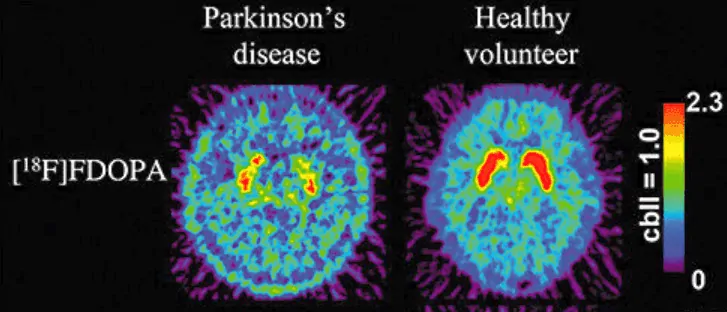
All doctors and possibly all patients should know what can mimic Parkinson’s disease. There are more than 30+ diseases that produce similar similar symptoms.
These mimics may cause Parkinson’s misdiagnosis. For example, hypothyroidism also produces slowness of movements. Therefore hypothyroidism can be misdiagnosed as Parkinson’s disease.
The treatment is different for each of these conditions. Misdiagnosis may lead to ineffective treatment.
A DAT scan (or F-DOPA PET scan) of the brain can confirm the diagnosis.
Hello! I am Dr Siddharth Kharkar, a Neurologist in Thane, India and a Neurologist in Mumbai, India. I provide Parkinson’s treatment in India and am an Epilepsy specialist in India. I provide Epilepsy surgery in India at Mumbai & Parkinson’s surgery in India.
Come, let’s learn together about diseases that can be very similar in presentation to Parkinson’s disease.
What can mimic Parkinson’s Disease?
Table of Contents
ToggleBefore we proceed, let’s take a minute to understand some basic stuff.
Here is a collection of 4 extremely important movement problems.
| 4 movement problems = “Parkinson-ism” |
|---|
| 1. Slowness (Bradykinesia, Hypokinesia or Akinesia) 2. Uncontrolled shaking (tremor) 3. Stiffness (rigidity) 4. Unsteadiness & shuffling gait. |
This group of problems is collectively called “Parkinsonism”. Parkinsonism means “like those produced by Parkinson’s disease”.
Many diseases produce Parkinsonism. Of course, the most common one is Parkinson’s disease itself!
But, other diseases can mimic Parkinson’s disease by producing similar symptoms. These are called the “Parkinson’s Mimics”.
Let us talk about these Parkinson’s Mimics under 4 headings.
| Mimics of Parkinson’s Disease |
|---|
| 1. Drug-induced Parkinsonism 2. Parkinson’s Plus Syndromes 3. Mimics caused by brain destruction 4. Completely unrelated Mimics |
The most important Parkinson’s Mimic: Drug-Induced Parkinsonism
Certain medications can reduce the activity of Dopamine inside the brain.
These medications produce symptoms very similar to Parkinson’s disease. Tremor is usually not seen, but some people can even have tremor!
So, drug-induced movement problems can be tough to distinguish from Parkinson’s Disease.
This is the most important cause underlying Parkinson’s Misdiagnosis, by far.
The most important thing is carefully telling the doctor which medications you took recently.

If you are on any of these medications, your symptoms may be a side-effect of these medications.
| Type of medication | Examples |
|---|---|
| 1. Many medications used for psychiatric problems such as schizophrenia |
Haloperidol, Risperdal, Olanzapine, Aripiprazole, Trifluoperazine, Amisulpuride and many more. Clozapine and low dose Quetiapine usually do not cause problems. |
| 2. Some medications for mood and depression | Fluphenazine, Tranycypromine, Lithium |
| 3. Some anti-nausea / anti-vertigo medications | Metoclopramide, Levosulpiride, High doses of domperidone (30–40 mg/day), Flunarizine, rarely Cinnarizine |
| 4. Some heart and blood pressure medications | Amiodarone, Methyldopa |
Parkinson’s Plus Syndromes
You could think of these as the “evil sisters” of Parkinson’s disease.
These diseases can mimic Parkinson’s disease very closely. Misdiagnosis is very common in the early stages of these diseases.
They have the exact symptoms of Parkinson’s disease. But they also produce additional symptoms such as falling backwards. So, they are called “Parkinson’s Plus syndromes”.

For example, in one such condition called PSP, the person has trouble moving his eyes. He/She can look from side-to-side but has difficulty looking up or down.
Here is a video of a patient with PSP. This video has been posted on youtube by Dr Dusan Pavlovic.
This patient has trouble looking upwards. He can look downwards, but there is a slight difficulty in doing that as well.
When present, difficulty in looking downwards is highly suggestive of PSP.
Parkinson’s plus syndromes are the diseases that mimic Parkinson’s disease most closely. Misdiagnosis is very, very common.
Parkinson’s Plus syndromes are often mistaken for Parkinson’s disease in the early stages. As they progress and additional symptoms build-up, they are correctly diagnosed.
A table of such diseases is given below. You can read more in this article: What are the Parkinson’s Plus Syndromes?
| Parkinson’s Plus Syndrome | Additional Features |
|---|---|
| 1. Dementia with Lewy Bodies (DLB) |
DLB is the most similar to Parkinson’s disease. But patients with DLB also have:
|
| 2. Multiple Systems Atrophy (MSA) |
There is dysfunction of the “Autonomic Nervous System”. This part helps our brain to manage automatic actions like passing urine and sweating. So, MSA patients can have:
|
| 3. Progressive Supranuclear Palsy (PSP) |
PSP patients have:
|
| 4. Corticobasal Degeneration (CBD) |
CBD is a rare disease.
|
| 5. Many kinds of Dementia |
Dementia is a term for “losing memory”. Many causes of Dementia also produce Parkinson’s symptoms. These include:
|
Luckily, decreased Dopamine activity is the main problem in all these diseases. So, the treatment of these Parkinson’s Plus Syndromes is similar to Parkinson’s disease.
Mimics caused by brain destruction
Most of these diseases are due to damage caused by various chemicals.
This process also destroys brain cells which produce Dopamine. This can create a condition very similar to Parkinson’s disease.
| Name of the disease | Caused by |
|---|---|
| 1. Wilson’s disease | Excessive copper in the brain |
| 2. Neuronal Brain Iron Accumulation (NBIA) | Excessive iron in the brain |
| 3. Fahr’s disease | Excessive calcium in the brain |
| 4. Toxins |
Examples:
|
| 5. Lack of oxygen or blood supply |
|
| 6. Infections |
|

Completely Unrelated Mimics
These conditions have almost nothing in common with Parkinson’s disease, except that they look similar. Most importantly, their causes and treatments are very different.
It is like saying that the Moon and the Sun are similar because both are round.
These diseases that mimic Parkinson’s are usually easy to spot. Unfortunately, misdiagnosis is still possible.
The tremor of Parkinson’s disease occurs even at rest. Hence it is called a rest tremor. Very few other conditions produce rest tremor.
But, many other diseases produce a tremor which is seen only when moving, for example when writing. This is called an Action tremor or posturokinetic tremor. Even these diseases are sometimes misdiagnosed as Parkinson’s disease.
| Causes of Rest Tremor | Causes of Action Tremor |
|---|---|
|
1. Parkinson’s disease 2. All other causes described so far 3. A condition called Dystonia 4. Strokes in some regions of the brain (such as the thalamus and red nucleus) |
1. Essential Tremor 2. Excessive stress, coffee or smoking 3. Medications such as bronchodilators, valproate and lamotrigine 4. Chromosomal problems such as Fragile-X syndrome 5. Parkinson’s disease itself! And many others… |

Please read the article on non-Parkinson’s causes of Bradykinesia. It describes 8 causes of slow movements.
The most important ones to remember are hypothyroidism and severe depression. The slowness of movements produced by these conditions can look the same as Parkinson’s disease.
Please read the article on shuffling gait. It describes 5 causes of shuffling of gait.
The most crucial mimic to remember is Normal Pressure Hydrocephalus (or NPH).
The person with NPH feels like he is stuck to the ground. This is a “magnetic gait”. It is easy to mistake this for Parkinson’s disease.
For example, see this video posted by the Hydrocephalus Association of America on youtube:
NPH can be treated by implanting a small shunt pipe. This shunt drains excess water around the brain into the abdomen.
Which test can be done when the diagnosis is in doubt?
I request a small set of tests on almost all patients I diagnose with Parkinson’s. These detect some (but not all) mimics of Parkinson’s disease.
Some doctors don’t request all these tests. And for a good reason.
The diagnosis of Parkinson’s mimics is primarily based on a careful history and examination. Even in my practice, these tests change the diagnosis only in a minority of patients.
I like the additional confirmation provided by these tests. They also have other benefits. For example, they help me determine the proper dosages of medications like Amantadine.
| Simple tests to detect Parkinson’s Mimics |
|---|
|
1. MRI-Brain – with size measurements of brain parts called the midbrain and pons. I usually also request a unique picture called SWI, which shows iron inside the brain. 2. Blood tests:
|
But when the diagnosis s really in doubt, there is another brain scan that can be done.
A Trodat scan. Or even better – an F-DOPA scan. Both these scans measure dopamine activity inside the brain.

You can read more about Trodat & F-DOPA scans by clicking here.
These scans are not perfect. Let me tell you why very quickly:
In Parkinson’s disease, dopamine activity inside the brain is deficient. This deficiency produces an abnormal scan. If the Trodat/F-DOPA scan is normal, it is unlikely that you have Parkinson’s disease.
Unfortunately, an abnormal scan means that you either have Parkinson’s disease, or a mimic. This is because some (but not all) of these mimics can also produce abnormal scans.
Bottom-line:
Parkinson’s misdiagnosis is common.
There are 30+ diseases that can mimic Parkinson’s disease.
The exclusion of Parkinson’s mimics depends on you providing a detailed history and a thorough examination by your doctor.
Testing (especially a DAT scan or F-DOPA PET scan) may help in difficult cases.
Caution: This information is not a substitute for professional care. Do not change your medications/treatment without your doctor’s permission.
